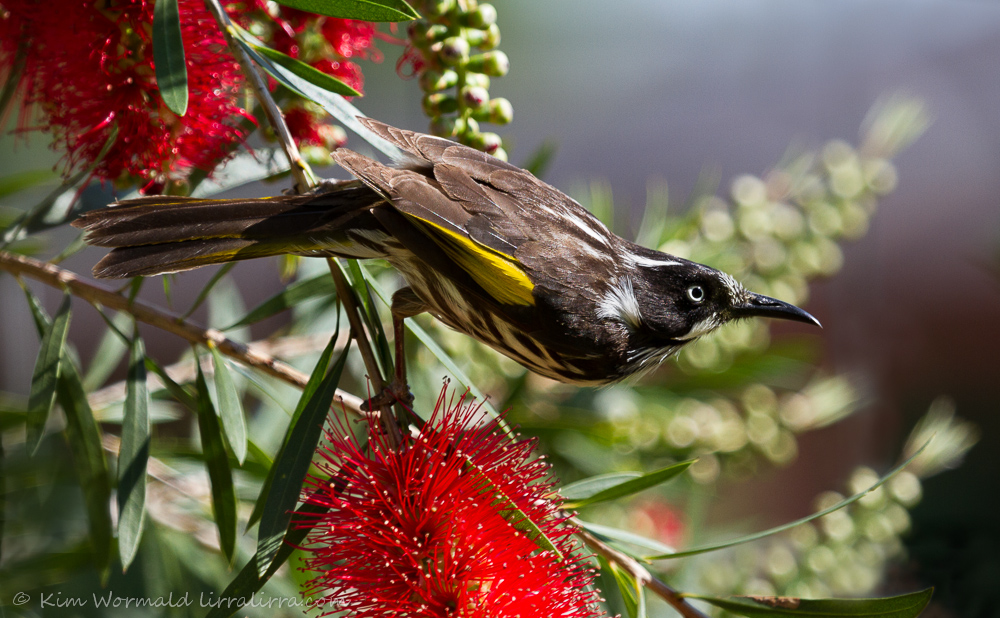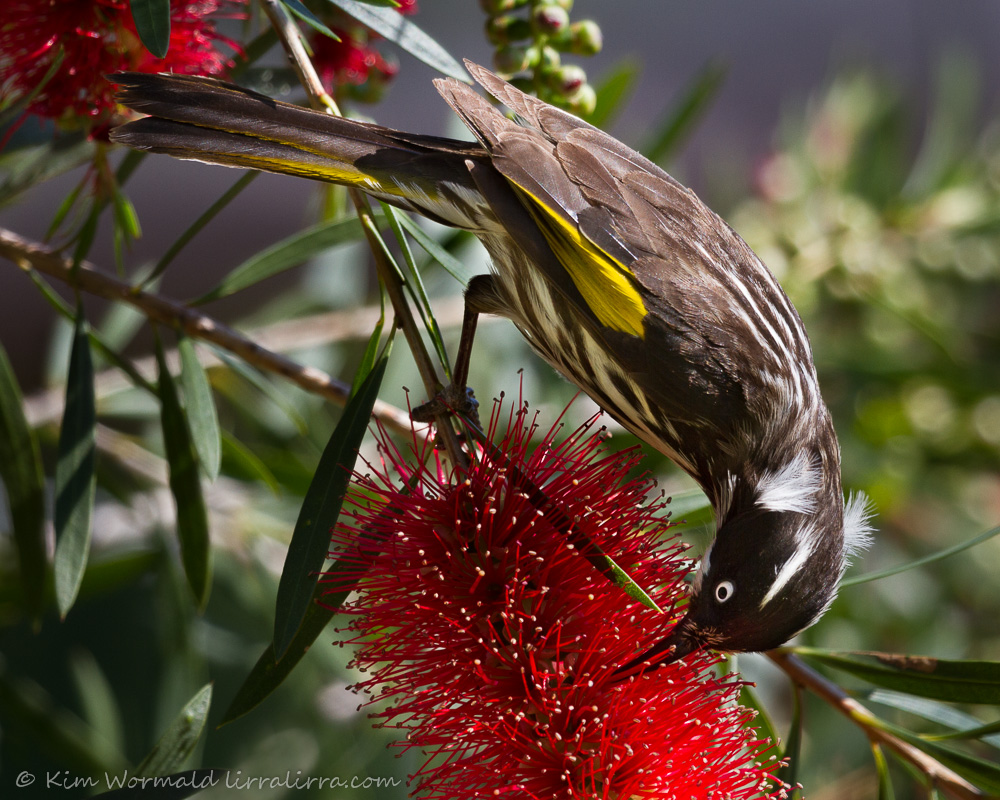Closer to home this week, and hiding under my photography blind, I was treated to a morning watching New Holland Honeyeaters visiting the flowering bottlebrush.
 New Holland Honeyeater
New Holland Honeyeater
Canon 7D, 100-400mm L IS USM, 1/500, f/5.6, ISO 250, focal length 310mm
New Holland Honeyeaters are busy birds that dart from flower to flower to probe with their long bills, and even longer tongues, for nectar. They are 18cm long and weigh about 20g. They are distinctive looking honeyeaters with bold black stripes on their underparts and large yellow patches on their wings. They are very similar to the White-cheeked Honeyeater that I saw for the first time in Ingham.
Eye-contact looks great in bird photography but it does mean that the bird has been disturbed enough to look at the camera. Sometimes I like watching in secret, as I did with these honeyeaters. In the image above the bird was unaware of me sitting camouflaged amongst the shrubbery, instead it was keeping an eye on a White-faced Heron that was catching skinks from the long grass.
 New Holland Honeyeater
New Holland Honeyeater
Canon 7D, 100-400mm L IS USM, 1/500, f/5.6, ISO 250, focal length 390mm
The honeyeaters flitted from blossom to blossom, quickly probing each flower a couple of times before moving on. I like the way the bird’s ear tufts are standing to attention while it feeds.
It was my first successful shoot under the hide. It became a bit hot in there despite the cool day and the fabric being breathable. The wind whipped up at one point and fresh air penetrated the fabric which made me more comfortable but meant that the bottlebrush were blowing around too much to take photographs; those windy moments were perfect for heron watching.
Happy birding, Kim
NB It is possible to receive a weekly email letting you know that lirralirra has been updated – just add your address to the ‘Subscribe to email’ box above right.
Also, I recently added a Facebook ‘like’ button. Thank you ‘likers’ – I like you too!

Kim, as always, amazing shots! So glad you suffered the blind!
Thanks Sherry, I’m looking forward to using it again but will dress for the tropics.
What a beautiful bird! Awesome shots!
Thank you Eileen!
Hello Kim
Fabulous !!!! Greats photos, and this bird is very very beautifull !
He has Indian feathers on the head ☺
Bravo and THANK YOU
The thought of Indian feathers on his head made me chuckle. I’m glad you like the images Nathalie 🙂
hoo it s a nice attitude on the 1st shoot, and 2 very nices photo kim
i ve the same tree in my garden… there nice flowers in the summer, but i never see this bird on it looool
take care and happy birding ☺
I didn’t know you had bottlebrush in France! How funny. I hope you have lots of French honeyeaters visiting.
They are gorgeous. Thank you for the discomfort you endured to capture them. And thank you for sharing the avian joy.
Thank you EC. Whatever the weather next time I’m in the hide I’ll dress for the tropics.
I particularly like the second photo. It captures the intensity of the feeding behavior of the bird. The perceived “intensity” seems to derive in large part from the strong contrast between the dark feathers of most of the head and body and the white of the iris and the ear tufts. In other words, I don’t think I would view the behavior as intense if the eye color were not so conspicuous.
Your observations made me look at the photos again and I see what you mean! It also made me think about how vulnerable they are when they have their heads down as they feed, no wonder there is such intensity and speed about the process.
The busy fluttering of New Hollands in the garden always remind me of summer.
Judy and I are off to Byron Bay next week and expect to see White-cheecked Honeyeaters. You are right, at first glance the look very much like New Hollands.
I hope you and Judy are having a great time in Byron Bay and seeing lots of lovely birds 🙂